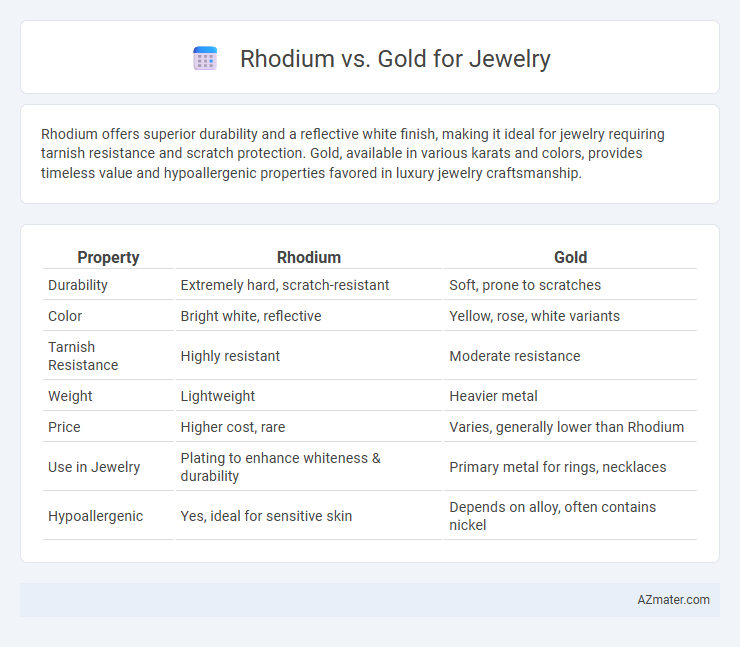Rhodium offers superior durability and a reflective white finish, making it ideal for jewelry requiring tarnish resistance and scratch protection. Gold, available in various karats and colors, provides timeless value and hypoallergenic properties favored in luxury jewelry craftsmanship.
Table of Comparison
| Property | Rhodium | Gold |
|---|---|---|
| Durability | Extremely hard, scratch-resistant | Soft, prone to scratches |
| Color | Bright white, reflective | Yellow, rose, white variants |
| Tarnish Resistance | Highly resistant | Moderate resistance |
| Weight | Lightweight | Heavier metal |
| Price | Higher cost, rare | Varies, generally lower than Rhodium |
| Use in Jewelry | Plating to enhance whiteness & durability | Primary metal for rings, necklaces |
| Hypoallergenic | Yes, ideal for sensitive skin | Depends on alloy, often contains nickel |
Introduction to Rhodium and Gold in Jewelry
Rhodium, a rare and lustrous white metal from the platinum group, is prized in jewelry for its reflective surface and exceptional resistance to tarnish and scratches. Gold, renowned for its malleability and classic yellow hue, remains a timeless choice in jewelry, often alloyed to enhance durability and available in various karats indicating purity levels. Both metals serve distinct purposes: rhodium primarily as a plating agent to enhance white gold and silver, and gold as the essential material for rings, necklaces, and other fine jewelry pieces.
Physical Properties: Rhodium vs Gold
Rhodium boasts remarkable hardness and a high melting point of 1,964degC, making it significantly more durable and scratch-resistant than gold, which melts at 1,064degC. Gold is highly malleable and ductile, allowing for intricate jewelry designs, while rhodium's brittleness limits its use to plating rather than standalone pieces. Both metals have excellent corrosion resistance, but rhodium's reflective, bright white finish contrasts with the warm, yellow luster of gold, influencing their application in jewelry aesthetics.
Appearance and Aesthetics
Rhodium offers a brilliant, reflective white finish that enhances the shine and modern appeal of jewelry, often used to plate white gold or silver for a sleek, polished look. Gold provides a warm, rich yellow or rose hue that conveys classic elegance and timeless luxury, with variations like white or rose gold catering to different aesthetic preferences. The choice between rhodium and gold depends on the desired jewelry style, with rhodium favored for its durability and hypoallergenic properties while gold remains prized for its intrinsic value and traditional beauty.
Durability and Wear Resistance
Rhodium offers superior durability and wear resistance compared to gold, making it an excellent choice for jewelry that requires long-lasting shine and protection from scratches. Unlike gold, rhodium is highly resistant to tarnishing and corrosion, ensuring jewelry retains its luster over time, especially when used as a plating material on white gold or silver. Gold, while softer and more prone to scratches, provides a classic appeal with varying karat options that balance durability and purity for everyday wear.
Hypoallergenic Qualities
Rhodium is highly valued in jewelry for its excellent hypoallergenic properties, making it suitable for individuals with sensitive skin or metal allergies. Unlike gold, especially lower-karat varieties that contain nickel or other allergenic metals, rhodium plating creates a smooth, non-reactive surface that reduces the risk of irritation or allergic reactions. Gold alloys with higher purity such as 18K or 24K have lower allergenic potential, but rhodium's durable, tarnish-resistant coating remains the preferred choice for hypoallergenic jewelry finishes.
Maintenance and Care Differences
Rhodium-plated jewelry requires periodic re-coating to maintain its reflective, tarnish-resistant surface, while solid gold pieces need regular polishing to preserve their natural luster and prevent scratches. Rhodium is hypoallergenic and resistant to corrosion, reducing the need for intensive cleaning compared to gold, which can tarnish and develop patina over time. Both metals benefit from gentle cleaning with mild soap and avoiding harsh chemicals, but gold's softness demands more careful handling to avoid dents and deformation during maintenance.
Cost Comparison: Rhodium vs Gold
Rhodium plating is significantly less expensive than solid gold jewelry, with rhodium prices averaging around $500 per ounce compared to gold's approximate $2,000 per ounce market value. While rhodium offers a durable, reflective finish at a lower price point, gold's intrinsic value and variety of karats (such as 14K, 18K, and 24K) lead to higher costs and greater investment potential. Buyers seeking affordable luxury often choose rhodium plating to enhance jewelry appearance without the premium cost associated with pure or alloyed gold.
Popular Jewelry Applications
Rhodium is often used as a plating material to enhance the durability and shine of white gold and silver jewelry, providing a reflective, tarnish-resistant finish highly favored in engagement rings and bridal sets. Gold, available in various karats and colors such as yellow, white, and rose, remains a timeless choice for rings, necklaces, and bracelets due to its malleability and hypoallergenic properties. The combination of white gold jewelry plated with rhodium maximizes aesthetic appeal and longevity, making it a popular choice for fine jewelry collections.
Environmental and Ethical Considerations
Rhodium, often used as a plating material for jewelry, has a smaller environmental footprint compared to gold, as its extraction involves less extensive mining operations. Gold mining is associated with significant environmental degradation, including deforestation, toxic chemical use, and water pollution, raising serious ethical concerns. Ethically sourced rhodium and recycled gold offer more sustainable options, reducing ecological impact and promoting responsible supply chains in the jewelry industry.
Which is Better for Jewelry: Rhodium or Gold?
Gold remains the preferred choice for jewelry due to its natural luster, durability, and hypoallergenic properties, making it ideal for daily wear and investment purposes. Rhodium, often used as a plating material for white gold or silver, enhances jewelry with a bright, reflective finish and increased scratch resistance but lacks intrinsic value and can wear off over time. For long-term jewelry ownership, solid gold offers better value and durability, while rhodium plating is best suited as a protective layer to improve appearance and longevity.

Infographic: Rhodium vs Gold for Jewelry
 azmater.com
azmater.com